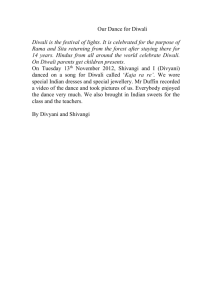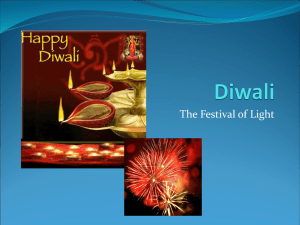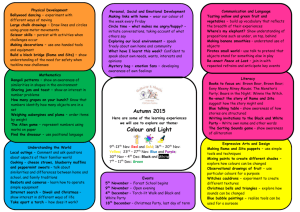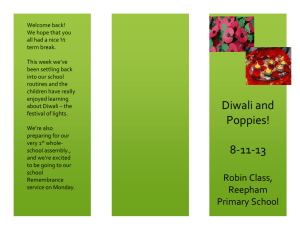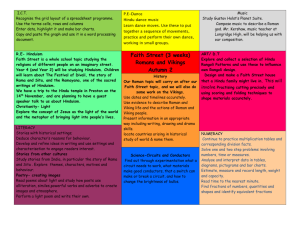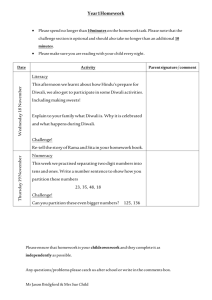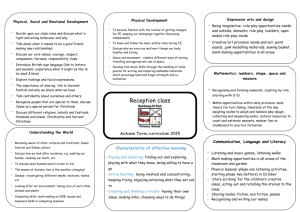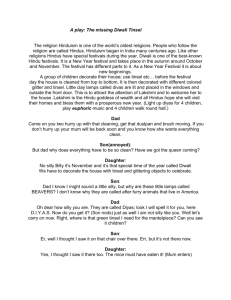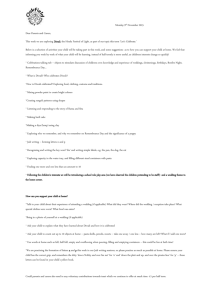Hinduism unit1
advertisement
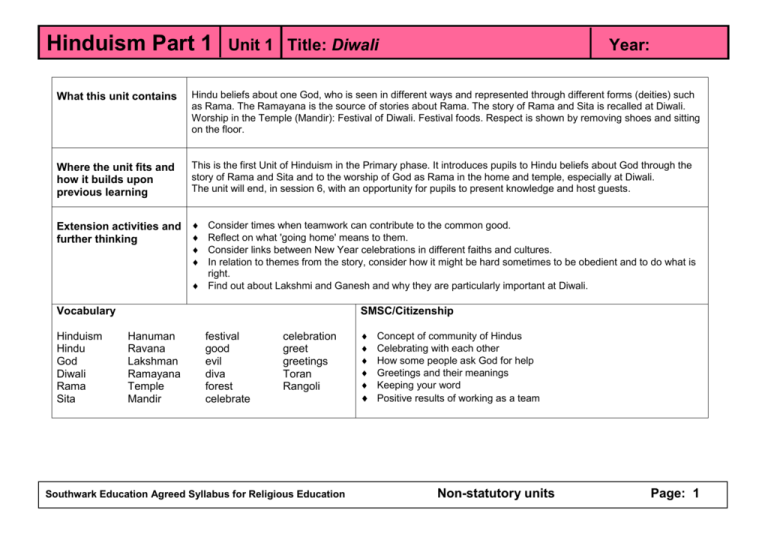
Hinduism Part 1 Unit 1 Title: Diwali Year: What this unit contains Hindu beliefs about one God, who is seen in different ways and represented through different forms (deities) such as Rama. The Ramayana is the source of stories about Rama. The story of Rama and Sita is recalled at Diwali. Worship in the Temple (Mandir): Festival of Diwali. Festival foods. Respect is shown by removing shoes and sitting on the floor. Where the unit fits and how it builds upon previous learning This is the first Unit of Hinduism in the Primary phase. It introduces pupils to Hindu beliefs about God through the story of Rama and Sita and to the worship of God as Rama in the home and temple, especially at Diwali. The unit will end, in session 6, with an opportunity for pupils to present knowledge and host guests. Extension activities and Consider times when teamwork can contribute to the common good. Reflect on what 'going home' means to them. further thinking Consider links between New Year celebrations in different faiths and cultures. In relation to themes from the story, consider how it might be hard sometimes to be obedient and to do what is right. Find out about Lakshmi and Ganesh and why they are particularly important at Diwali. Vocabulary Hinduism Hindu God Diwali Rama Sita SMSC/Citizenship Hanuman Ravana Lakshman Ramayana Temple Mandir festival good evil diva forest celebrate celebration greet greetings Toran Rangoli Southwark Education Agreed Syllabus for Religious Education Concept of community of Hindus Celebrating with each other How some people ask God for help Greetings and their meanings Keeping your word Positive results of working as a team Non-statutory units Page: 1 Hinduism Part 1 Unit 1 Title: Diwali Year: Unit 1 Session 1 Learning objectives Pupils should: recall festivals and celebrations that pupils have enjoyed; A T 1 Suggested teaching activities Focus for assessment Before the lesson ask pupils to bring to class evidence of celebrations that they have experienced (cards, photographs etc.) Through a whole - class discussion about festivals collate information for a class display. Pupils should recall times when they have shared celebrations with others. What can they remember? Collect information under the following headings: Name of festival / celebration; How is it celebrated / what did you do? What stories are told? Is it a festival belonging to a religion? (If so, which one?) Did you, or anyone else you know, celebrate at a place of worship? understand that some festivals are special to particular religions; know ways that people celebrate, e.g. sharing food, sending cards and telling stories; A T 2 know some of the ways that Hindus celebrate at the festival of Diwali. Sensitivities, points to note resources Resources: Hindu Aum symbol Diwali card Diva Images including pictures or murtis of Rama, Sita & Hanuman Indian sweets, Bombay mix etc plasticine / clay/ dough for divas materials for class display Introduce pupils to the Hindu festival of Diwali. Explain that Hinduism is a religion that began in India. Show and explain the Hindu symbol, Aum, linking it to the religion. Show pupils the artefacts and explain that the festival involves people sending cards, sharing special food and lighting divas. Draw parallels with the other festivals discussed in the lesson. Add information about Diwali under each of the four headings and display. Showing images of the appropriate deities explain that there is a very exciting story about Rama and Sita that is retold at this festival, which the next lesson will explore. Make plasticine / clay/ dough divas and share sweets or Bombay mix together. Southwark Education Agreed Syllabus for Religious Education Non-statutory units Page: 2 Hinduism Part 1 Unit 1 Title: Diwali Year: Unit 1 Session 2 Learning objectives Pupils should: know that the story recalled at Diwali is set in India, a hot country where the forest contains plants and creatures very different from those in the UK; know the story of Rama and Sita as told at Diwali and written in a special book called the Ramayana; A T 1 A T 2 Focus for assessment To remind pupils of the festival of Diwali, show them the short piece of film 'Diwali part1' from the ‘Faiths’ CD-Rom. This explores a range of exciting ways that the festival is celebrated in London and also introduces pupils to the belief that Hindus worship Rama, who they believe is a form of God. Set the scene for the story of Rama and Sita. Explain that India is a hot country and talk about the foods that might be eaten, clothes that might be worn and creatures that might be found in a forest. You might decorate the classroom as an Indian forest or palace. Tell the story or watch a video of the story of Rama and Sita. Explain that the story has been written down in a special book called the Ramayana. Ask questions about characters' feelings at different points in the story, e.g. Rama when leaving home, Sita on arrival in the forest, Hanuman finding Sita, Sita being rescued, Rama and Sita going home. Emphasise that Rama was a good, loyal son, Sita was confident Rama could protect her. know that Hindus worship Rama; identify the feelings of characters in the story and the qualities they demonstrate, e.g. Rama was an obedient son. Suggested teaching activities Write either: a) a postcard that Rama or Sita might have sent to a friend or member of their family while they were living in the forest explaining how they feel and what it is like or; b) a diary entry by one character of a day in his/ her life. After the lesson, add new information and postcards to the class festivals display. Southwark Education Agreed Syllabus for Religious Education Non-statutory units Sensitivities, points to note resources Resources: Indian music Faiths CD Rom (LgFL/ Espresso)- Diwali Part 1 Story of Diwali on Tape / Video or book, e.g. 'A row of lights - the story of Rama & Sita' Lynne Broadbent & John Logan, RMEP Visual Aids of characters from the story Images of Indian scenery and wildlife 'Postcard' paper Copy of the Ramayana Heart of Hinduism Primary pack: Teacher Guides Animals 4.1 Plants & trees 4.2 Teaching ideas Visualisation of India 1.1. Page: 3 Hinduism Part 1 Unit 1 Title: Diwali Year: Unit 1 Session 3 Learning objectives A T 1 A T 2 know why a diva is a symbol associated with Diwali. Focus for assessment In this lesson you will reinforce the pupils' understanding of this through drama or role-play. Use Indian music or tapes with sounds of a forest to add atmosphere to your play. Pupils should: know the story of Rama and Sita; consider what it feels like to go home and realise that this is one theme of the story; Suggested teaching activities Explore themes in the story through the drama - for example Sita following her husband into exile, Sita stepping out of the circle, Rama and Lakshman's desperate search for Sita, the teamwork shown by the monkey army, the battle of good and evil, Sita and Rama going home and everyone celebrating. Recall the story of Rama and Sita told in the previous lesson. Generate a list of words to describe each of the main characters and talk about how to show these personal qualities during the drama. After the practical session, light a diva and talk about how many divas lit the way home for Rama and Sita. Set out the children’s divas and count them. Consider how many more divas there might have been for Rama and Sita. How might the divas make coming home more welcoming for Rama and Sita? Discuss what makes home welcoming. (Continued on next page) Southwark Education Agreed Syllabus for Religious Education Non-statutory units Sensitivities, points to note resources Resources: Music - Indian Rainforest / jungle sounds Heart of Hinduism Primary pack: Teacher Guides 2.5 'Characters in the Ramayana' Audio CD 'Sounds of Vrindavan' Divas Nightlights Role-play / drama clothes Pupils’ divas from previous lesson Possible numeracy link: You could estimate and then, using the children’s divas, check the number of divas needed to be used to light the way between the classroom and the hall, the classroom and the playground or other local ‘’journeys’ to give pupils an idea of the number of divas that might have been needed. (Continued on next page) Page: 4 Hinduism Part 1 nit 1 Title: Diwali Year: Unit 1 Session 3 continued Learning objectives A T 1 A T 2 Suggested teaching activities Focus for assessment (Continued from previous page) (Continued from previous page) Complete a short response sheet. 'I think Rama and Sita must have felt………. When they saw the lights as they went home' or on monkey shaped paper write why working in teams helps people to do something difficult. Add outcomes to the display. Southwark Education Agreed Syllabus for Religious Education Sensitivities, points to note resources Non-statutory units NB (i) Health & Safety - Take care of fire hazards when lighting divas; ensure appropriate fire precautions are taken. (ii) It is important that pupils appreciate that good and evil are not associated with particular people or races Page: 5 Hinduism Part 1 Unit 1 Title: Diwali Year: Unit 1 Session 4 Learning objectives A T 1 Pupils should: know some ways that Hindus celebrate Diwali, including sending cards; know some Hindu symbols associated with this festival and with deities; consider ways that members of different cultures welcome people. A T 2 Suggested teaching activities Focus for assessment Recall knowledge from previous lessons about ways that people celebrate Diwali. Talk about ways that members of the class welcome others into their homes. Try out different ways of saying ‘hello’ and ‘welcome’. Examine a Toran or show pupils the Toran designs across every page of ‘My Hindu Faith’. Consider a Toran may be used to decorate homes and welcome family and friends into your personal place during a Hindu celebration. Look at Diwali cards and identify what they represent. Watch the brief film about Rangoli patterns in the ‘Faiths’ CD-Rom. Make individual cards, Rangoli patterns and shapes to make up a class Toran to mark Diwali. Symbols or images of characters from the story, divas, ‘Aum symbol’, images of Ganesh the deity of new beginnings or ventures may be used, as this is the new year festival. Decorate the classroom. Send card invitations to members of another class, staff or governors to see how the class has been decorated and to find out about the festival during lesson 6. Plan to welcome ‘guests’ with fruit / sweets and welcome greetings from a range of cultures / faiths. Southwark Education Agreed Syllabus for Religious Education Non-statutory units Sensitivities, points to note resources Resources: ‘Aum’ symbol Divas Diwali cards Toran (decorative garland often used over doorways to welcome guests and bring good fortune). Coloured dried rice Hindu symbols and images of deities – Hanuman, Ganesh, Rama, and Sita. ‘ Faiths CD Rom (LgFL/ Espresso)- ‘Rangoli’ Art materials, e.g. toran shaped bright paper, card, paints, pastels etc. ‘My Hindu Life’ p 22 ‘My Hindu Faith’ pages 20-21 http://www.123greetings.com/ev ents/diwali/wishes/ NB It is auspicious to have an odd number of shapes for a Toran and it would be good to have both sides of it decorated so that members of the class can enjoy it as well as it inviting / welcoming those entering from outside. Page: 6 Hinduism Part 1 Unit 1 Title: Diwali Year: Unit 1 Sessions 5 & 6 Learning objectives Pupils should: consider ways that people are welcomed into school or home and know that hospitality is important to Hindus; know how Hindus might worship in their homes or the Temple at Diwali; know that Arti is a welcoming ceremony and recognise some artefacts used during Arti / puja; know that Diwali is a new year festival and that Lakshmi and Ganesh are also worshipped at Diwali. A T 1 A T 2 Suggested teaching activities Focus for assessment During session 6 guests should be hosted in the classroom for a presentation of the story of Diwali and an explanation of how Hindus celebrate the festival. Discuss ways that people announce their arrival at your home or at school. - Talk about doorbells and knocking on doors. Show video sections showing worship at Diwali in a Hindu home and temple. Stop the video to encourage pupils to identify artefacts, deities and symbols that they have studied. Focus pupils’ attention on the way that bells are rung to announce to the deity that people have come to worship, also how light is used to welcome the deity. Point out how people remove their shoes as a sign of respect when they are worshipping. Discuss why people like new ‘starts’, e.g. new notebooks, new terms, new years and why they might ask for help at such times. Complete a short response sheet ‘At new year I try to have a ‘new start because…’ Decorate this with an image of Ganesh, recalling he is the deity of new beginnings. Sensitivities, points to note resources Resources: ' Faiths CD Rom (LgFL/ Espresso)- 'Worship in the home' Videos: ‘Pathways of Belief’ Hinduism ‘Water, candle, moon, tree & sword’ Water section Images of Ganesh and Lakshmi Short response sheet N.B. Hindu hospitality includes 3 requisites; Giving a place to sit Providing refreshments Offering some words of welcoming / pleasant words. (Continued on next page) Southwark Education Agreed Syllabus for Religious Education Non-statutory units Page: 7 Hinduism Part 1 Unit 1 Title: Diwali Year: Unit 1 Session 5 & 6 continued (Continued from previous page) Assessment Levels Decorate the classroom with pupils’ work and artefacts. Decide who will greet guests and how they will be entertained with the story of Rama and Sita during the next lesson. Level 1 Attainment target 1 Pupils use some religious words and phrases to recognise and name features of religious life and practice. They can recall religious stories. Assessment Task: During lesson 6 welcome & host guests to a presentation of the story. This provides an opportunity to assess pupils’ knowledge and understanding of the festival and how it is celebrated. Welcome guests using a range of religious and cultural greetings and play Indian music and atmospheric music whilst the celebration and story take place. Give guests juice / fruit/ sweets, welcoming words etc to ensure they feel welcomed. Southwark Education Agreed Syllabus for Religious Education Level 2 Attainment target 1 Pupils use religious words and phrases to identify some features of religion and its importance for some people. They begin to show awareness of similarities in religions. Pupils retell religious stories and suggest meanings for religious actions and symbols. They identify how religion is expressed in different ways. Non-statutory units Page: 8 Hinduism Part 1 Unit 1 Title: Diwali Year: Hinduism Unit 1 Session 4 A Toran This unique door hanging in cotton and silken threads shows auspicious Rajasthani motifs amidst floral designs and dancing peacocks. On the top, it has the deity Ganesh- the God of prosperity and new beginnings and is adorned with red and orange borders. Southwark Education Agreed Syllabus for Religious Education Information sheet Page: 9
